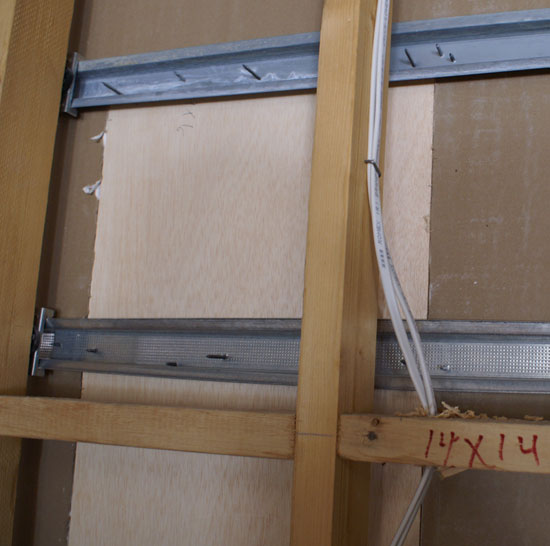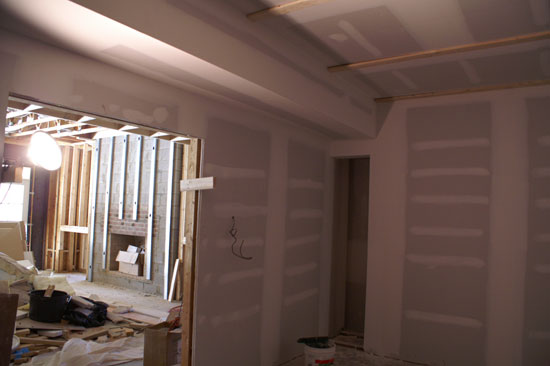TheaterBlog: Drywall Goes Up, Soundproofing the Room Part II
by Anand Lal Shimpi on January 17, 2008 12:00 AM EST- Posted in
- Anand
I couldn't get any updates done before or during CES week, sorry guys. Luckily not too much more has happened, but I thought I'd pick up where I left off. I had a lot of metal on the walls and ceiling, and insulation behind them, it was time to drywall. Remember, at this point nothing should screw into the wooden studs that framed the room, anything I wanted to hang must go through the metal channels.

Two layers of standard 1/2" drywall - Click to Enlarge
Bryan recommended two layers of drywall, once again to cut down on sound transmission. Between the two layers of drywall we'd use something called Green Glue, a mild adhesive that is designed to dissipate vibration in the form of heat and thus limit transmission of sound between the two layers of drywall. Weight is the enemy of sound, so by having two layers of drywall I was already ahead of the game, and the green glue in between was icing on the cake. I couldn't find Green Glue locally, so that was yet another thing I had to order online.
I was concerned about hanging a projector or speakers off of nothing but these metal channels, what would happen if the projector mount didn't line up with where I had a channel in the room? Bryan suggested that we figure out the locations we were going to be hanging things from the ceiling or walls, and reinforce those areas.
We reinforced by running additional RSIC channels, and cutting out parts of the first layer of drywall and replacing it with wooden boards. The second layer of drywall would remain as is, but behind it we'd have a large panel of wood attached to multiple RSIC channels that we could safely mount anything to.
I had a general idea of where the projector would go and thanks to Bryan and Ryan, I knew where my speakers and wall sconces would go. The guys who hung the drywall in the rest of my house tackled the theater room; they were mostly confused as to why I was doing this and they weren't really happy with the added cutting and greengluing but they got the job done.
The DIY element of my theater was really split depending on what it was I was doing. Things like hanging drywall I left to those who were actually skilled at such things, whereas more delicate things like making the starfield ceiling I handled myself (with the help of whatever friends I could convince to aid me).
Drywall went up while I was out of town so I don't have too many pictures of the actual process, but other than the multiple layers and green glue, it's just like hanging any other drywall.


















16 Comments
View All Comments
TW - Saturday, January 26, 2008 - link
It does not perform as well as 8 sheets is my point. Never been tested, and likely never will.Standard drywall = $8
quiet rock 530 = $120
paperfist - Monday, February 11, 2008 - link
There's a show on Discovery Home called Holmes on Homes where they used that product to replace standard drywall between 2 homes with a shared wall. I don't remember the dB readings but they blasted a radio on one side of the wall and measured the sound on the other side. The results were nearly silent. In the previous state both home owners complained they could hear each others conversations clearly even in other ends of the house.Personally I used the double drywall 'trick' as recommended to me by my insulation contractor. What a waste that turned out to be, there's virtually no difference in noise transmission and the added costs both in materials and labor have to be considered to hang 2 sheets vrs one quiet rock sheet.
I'm def trying it out in the next room remodel :)
TW - Wednesday, February 13, 2008 - link
I saw that show also. Not the full story. To really analize what works best, you have to remove all the variables possible and have tests done in certified acoustic labs.As it happens, when you do this, you see that quiet rock isn't at the top of the food chain, is expensive and don't forget you have to throw away an average of 12% as waste.
paperfist - Tuesday, February 19, 2008 - link
Per your post below I assume you mean bat fiberglass as in insulation? I spent a lot of money on that stuff and it didn't remotely live up to expectations to dampen sound between floors.As far as lab testing and variables go I'm not sold. They played a radio between 2 walls and the sound transmission was obvious. They ripped the drywall down, insulated, used a sound deadening tape on penetrations and then finally used quiet rock. They replayed the radio and the difference was night and day.
True I'm sure there's some stuff going on behind the scenes, but lab testing means nothing to me. The EPA would like you to believe your car is going to get 30 MPG...in a lab. In the real world many of us know those numbers to be useless. In a lab or even on paper my SATA drive is suppose to wipe the floor with my ATA drives. It's not the case.
I never used quiet rock, but as I've said I'll be redoing my living room shortly which will include ripping down everything to the studs. If I can get my hands on the stuff I'll try it out. I don't remember the exact figure, something like it's like using 15 sheets of drywall? I'm certain they are stretching the truth on that one.
What do you consider to be the top of the food chain? From experience I can say the fiberglass bat insulation designed to deaden sound and double drywall didn't work for me.
TW - Tuesday, February 19, 2008 - link
Paper,Labs are the only way to isolate variables. Otherweise you have no idea at all what works and doesn't because of the dozens of possible contributing elements.
Quiet rock certainly works, but the "1 = 8" is just plain BS marketing.
There are only 4 things that can deal with sound:
Mass: like drywall, MLV, plywood, cement. All really heavy
Absorption: Generally used in hollow areas such as stud and joist cavities.
Decoupling: This separates the drywall from the studs or joists for example.
Damping: This is what quiet rock, green glue, etc do.
The problem with your ceiling project was that you had no decoupling. The footfall vibration completely overwhelmed what you did. Very common.
ltfields - Friday, January 18, 2008 - link
I hear ya on the Drywaller complaints, when I had a drywall contractor finish off my basement (since everyone I talked to said contract it out), they were a pain to deal with. They didn't want to drywall the underside of my staircase, and I fought with them on speaker mounts in my home theater as well(though I didn't do the isolation and gluing you did). If they didn't do such a good job, I'd be more angry, but it's like pulling teeth sometimes...